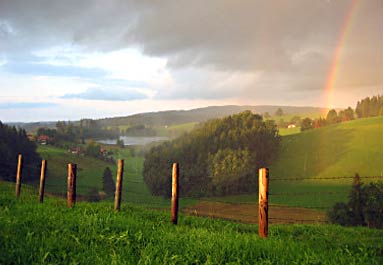This original column is provided free for one-time use with author credit at the end. It may be used for background with author credit. Copyright applies.
#75 FOR IMMEDIATE RELEASE: February 26, 2009
Trees and loggers: Television's stab at reality
By Curtis Seltzer
BLUE GRASS, Va.—Something’s up in television land. Have you noticed all the shows on loggers?
The History Channel brings us “AXMEN” about crews in Northwest Oregon, and this season we’re promised “they’re bigger, badder and tougher than ever.” The series has nothing to do with history or axes.
“American Logger” in Maine comes from the Discovery Channel. And we have occasional visits with helicopter logging, swamp logging and mule logging.
For years conservatives insisted that THE MEDIA is controlled by tree-huggers, do-gooders, aliens and plug-in-hybrid liberals who want to drag America back into wilderness.
So why is THE MEDIA -- in fact, the tree-huggin’est, do-goodin’ist eco-idiots in the bunch, Hollywood television-- now romanticizing guys who kill plants for a living?
Could the answer be, money?
These logger shows have two qualities that make them commercial winners. First, they’re cheap to produce. Loggers, if they’re considered actors at all, would be minimum scale. No sets or studio costs are involved, no rehearsals and only a few writers.
Second, they appeal to the part of our nature that likes to watch other people doing dangerous things--sometimes cheating hurt, sometimes not. One rule, of course, is a little blood helps ratings, but no one should be shown getting killed.
Television likes focusing on risky, “extreme” behavior for both reasons.
Maybe this has something to do with the increasing level of chronic jeopardy we now live with. Is it fair to say that 95 percent of us are one major illness from going over the waterfall? If you live on the edge, you like to watch others going over…and surviving.
So TV gives us cage fighters, Big Air snowboarders, Alaskan fisherpersons and loggers.
Some years ago when nice young women were sitting in tree tops and monkey-wrenchers were spiking trees, a “reality” show on loggers would have never seen digital daylight. Today, they have been Hollywoodized into working-class daredevils--the Logging Wallendas.
But does this rediscovery of loggers suggest a shift in THE MEDIA’s attitude toward using wood? Where once environmentalists of a certain stripe argued that trees and forests were best left alone, global warming and fossil-fuel dependency has pushed wood into, at least, the second rank of eco-friendly fuels.
A cost-competitive alternative to coal and fuel oil is wood pellets, which are used in residential stoves and by institutions and utilities. We now export pellets to European industries and power plants where they are burned with coal to generate electricity.
Pellets release less CO2 than coal, fuel oil and natural gas per unit of electrical energy. (www.stovesonline.co.uk/fuel-CO2-emissions.html.) They’re much friendlier than coal in terms of pollution from sulfur, nitrogen and mercury.
The iffier wood-based energy is ethanol. Several technologies are available, but none are sufficiently tested in a market free of federal grants and subsidies. The U.S. Department of Energy has helped with R&D and plant start-ups in Florida, Wyoming, Minnesota and Georgia where Range Fuels is building a 20-million-gallons/year facility.
Wood-based ethanol appears to be cheaper and better environmentally than corn-based ethanol, but hard numbers are not yet available. Right now, we don’t really know which wood-ethanol process is a winner, if any.
Pellets for electricity appear to be a simple, cost-effective and efficient way to move forward, especially to the extent that wood-waste materials are the feedstock. Pellets can back out dirtier fuels, particularly coal and fuel oil. A significant expansion of our pellet industry would use domestic resources in areas that need blue-collar jobs—places like the upper South, West Virginia, Michigan and the upper Midwest, upstate New York and rural Pennsylvania, northern New England, Pacific Northwest and the Southeast from Texas to Virginia.
A pellet market for forestry waste -- the tree tops often left on the ground after cutting -- would improve logging’s aesthetics. Pellets can also use low-value wastes -- sawdust, bark, chips, paper -- and other sources of biomass.
Trees are several hundred million years old. The ginko is the oldest, then the 600 species of conifers, then the flowering trees, which include everything from nutmeg, paw paw and magnolia (primitive angiosperms), then palms (a monocotyledon—one seed leaf) and, finally, the dicotyledons (the seed has two leaves), which include familiar deciduous species like maples and oaks. Trees give us fruits, nuts, coffee, tea, olives, cocoa, rubber, quinine, frankincense and myrrh, to mention a few gifts.
It’s fun to know a little about trees, particularly those you can name correctly without a tree-identification book when woods-walking with your spouse. A good ash spot goes a long way in clinching who knows what about things other than trees.
And if things get tight, drop in “dendrology,” which is the science of trees and the study of woody plants.
The best way to choose an identification book is to take a couple of unfamiliar leaves into a bookstore and page through what’s on the shelf.
Forested acreage in the United States is increasing. We know how to do logging with minimal environmental impacts. Many of us tend to assume that the raw, roughed up look of a recent cutting is the same as environmental harm. It’s not. There are good logging jobs and bad ones, but the basic truth is that trees, among their other virtues, are a sustainable resource that human beings have used, sometimes wisely, sometimes not, for thousands of years.
The television logging shows focus on the combat-like aspects of the work and the conflicts and antics of the colorful crews. Often, the camera prefers them as a bunch of professional wrestlers out in the woods using big, loud, scary machines and getting into jams.
Three of my closest neighbors are loggers, as are their sons. We know local guys who have been paralyzed or killed working in the woods. We think the camera is often driving what is being filmed. What the shows get right is how hard loggers work under extreme pressure for so little.
I’ve done enough woods work over the years to know how difficult and dangerous it is. I like seeing loggers being recognized. They are the front line for every scrap of paper and every stick each of uses every day.
As with many television shows, much of what we don’t see is the real reality behind what we are shown.
Curtis Seltzer, land consultant, is the author of How To Be A DIRT-SMART Buyer of Country Property at www.curtis-seltzer.com. He holds a Class A residential contractor’s license in Virginia and has lived in a now 90-year-old farmhouse for 25 years.
Contact: Curtis Seltzer, Ph.D.
Land Consultant
1467 Wimer Mountain Road
Blue Grass, VA 24413-2307
540-474-3297
curtisseltzer@htcnet.org
www.curtis-seltzer.com
This original column is provided free for one-time use with author credit at the end. It may be used for background with author credit. Copyright applies.
|









